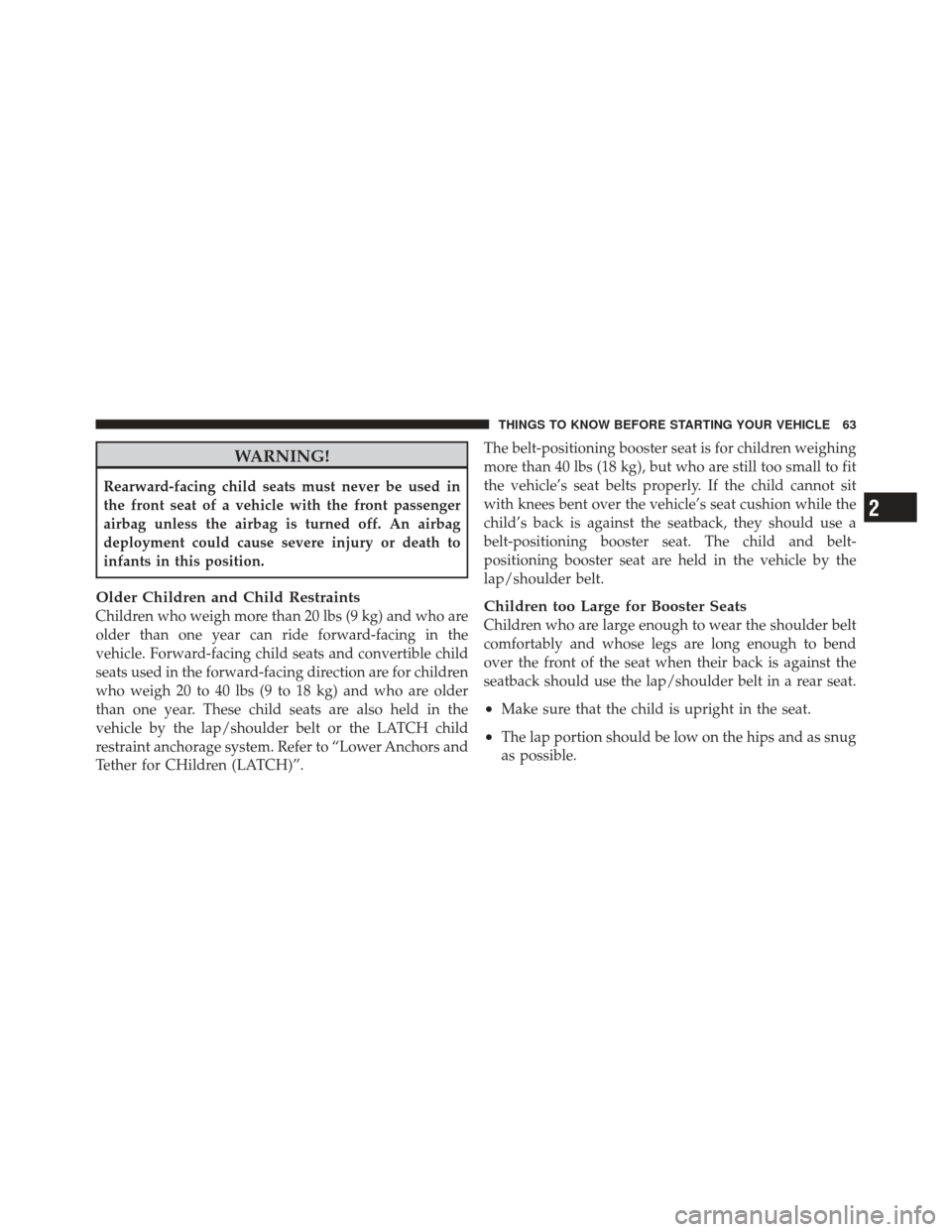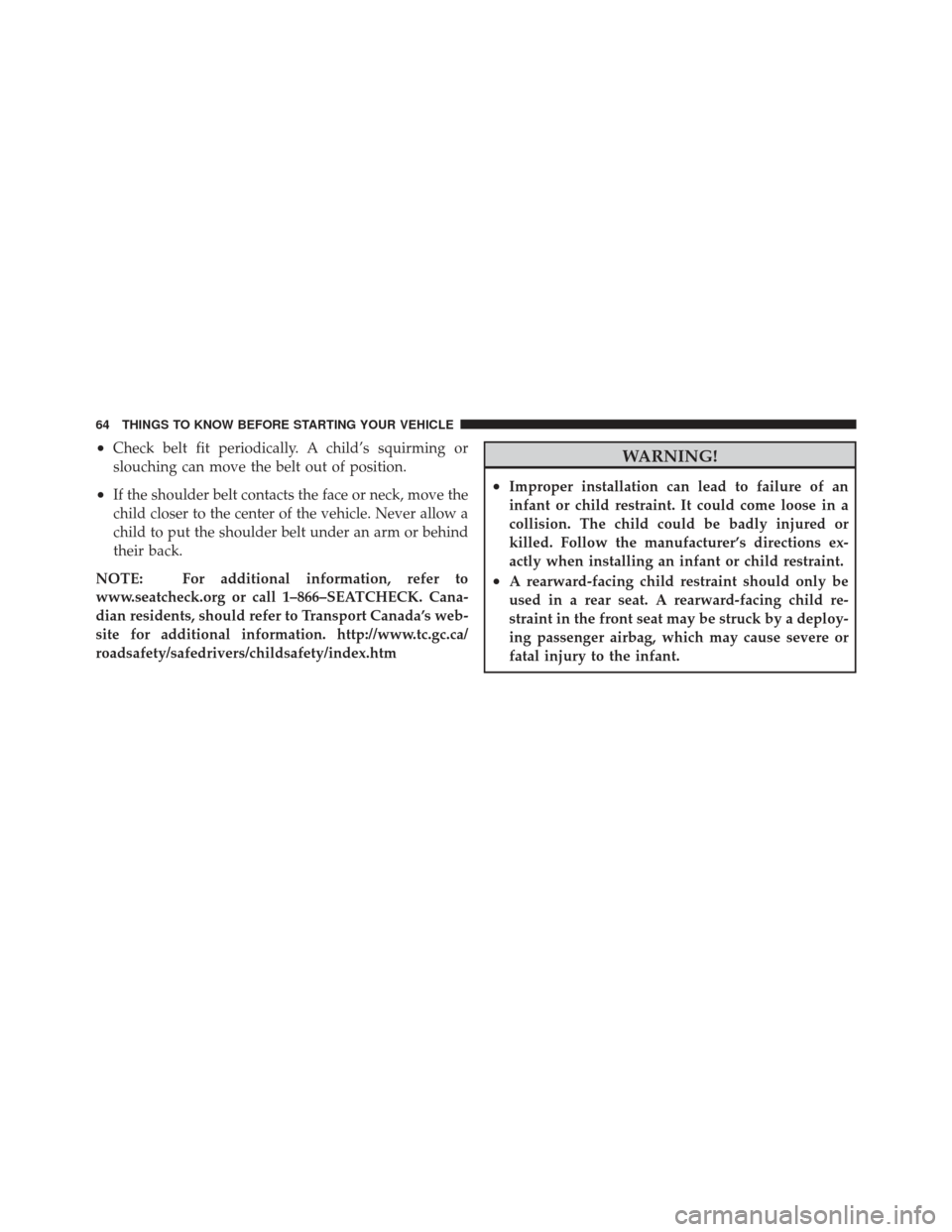2010 DODGE CHALLENGER airbag
[x] Cancel search: airbagPage 62 of 477

Airbag Warning Light
You will want to have the airbags ready to
inflate for your protection in a collision. The
airbag system is designed to be maintenance
free, if any of the following occurs, have an
authorized dealer service the airbag system immediately.
•The Airbag Warning Light does not come on during
the four to eight seconds when the ignition switch is
first turned to the ON/RUN position.
•The Airbag Warning Light remains on after the four to
eight-second interval.
•The Airbag Warning Light comes on intermittently or
remains on while driving.
NOTE: If the speedometer, tachometer, or any engine
related gauges are not working, the Occupant Restraint
Controller (ORC) may also be disabled. The airbags may
not be ready to inflate for your protection. Promptly check the fuse block for blown fuses. Refer to the label
located on the inside of the fuse block cover for the
proper airbag fuses. See your authorized dealer if the
fuse is good.
Event Data Recorder (EDR)
This vehicle is equipped with an event data recorder
(EDR). The main purpose of an EDR is to record, in
certain crash or near crash-like situations, such as an air
bag deployment or hitting a road obstacle, data that will
assist in understanding how a vehicle’s systems per-
formed. The EDR is designed to record data related to
vehicle dynamics and safety systems for a short period of
time, typically 30 seconds or less. The EDR in this vehicle
is designed to record such data as:
•How various systems in your vehicle were operating;
•Whether or not the driver and passenger safety belts
were buckled/fastened;
60 THINGS TO KNOW BEFORE STARTING YOUR VEHICLE
Page 65 of 477

WARNING!
Rearward-facing child seats must never be used in
the front seat of a vehicle with the front passenger
airbag unless the airbag is turned off. An airbag
deployment could cause severe injury or death to
infants in this position.
Older Children and Child Restraints
Children who weigh more than 20 lbs (9 kg) and who are
older than one year can ride forward-facing in the
vehicle. Forward-facing child seats and convertible child
seats used in the forward-facing direction are for children
who weigh 20 to 40 lbs (9 to 18 kg) and who are older
than one year. These child seats are also held in the
vehicle by the lap/shoulder belt or the LATCH child
restraint anchorage system. Refer to “Lower Anchors and
Tether for CHildren (LATCH)”.The belt-positioning booster seat is for children weighing
more than 40 lbs (18 kg), but who are still too small to fit
the vehicle’s seat belts properly. If the child cannot sit
with knees bent over the vehicle’s seat cushion while the
child’s back is against the seatback, they should use a
belt-positioning booster seat. The child and belt-
positioning booster seat are held in the vehicle by the
lap/shoulder belt.Children too Large for Booster Seats
Children who are large enough to wear the shoulder belt
comfortably and whose legs are long enough to bend
over the front of the seat when their back is against the
seatback should use the lap/shoulder belt in a rear seat.
•Make sure that the child is upright in the seat.
•The lap portion should be low on the hips and as snug
as possible.
2
THINGS TO KNOW BEFORE STARTING YOUR VEHICLE 63
Page 66 of 477

•Check belt fit periodically. A child’s squirming or
slouching can move the belt out of position.
•If the shoulder belt contacts the face or neck, move the
child closer to the center of the vehicle. Never allow a
child to put the shoulder belt under an arm or behind
their back.
NOTE: For additional information, refer to
www.seatcheck.org or call 1–866–SEATCHECK. Cana-
dian residents, should refer to Transport Canada’s web-
site for additional information. http://www.tc.gc.ca/
roadsafety/safedrivers/childsafety/index.htm
WARNING!
•Improper installation can lead to failure of an
infant or child restraint. It could come loose in a
collision. The child could be badly injured or
killed. Follow the manufacturer’s directions ex-
actly when installing an infant or child restraint.
•A rearward-facing child restraint should only be
used in a rear seat. A rearward-facing child re-
straint in the front seat may be struck by a deploy-
ing passenger airbag, which may cause severe or
fatal injury to the infant.
64 THINGS TO KNOW BEFORE STARTING YOUR VEHICLE
Page 72 of 477

NOTE:Ensure that the tether strap does not slip into the
opening between the seatbacks as you remove slack in
the strap.
WARNING!
An incorrectly anchored tether strap could lead to
increased head motion and possible injury to the
child. Use only the anchor positions directly behind
the child seat to secure a child restraint top tether
strap.
Transporting Pets
Airbags deploying in the front seat could harm your pet.
An unrestrained pet will be thrown about and possibly
injured, or injure a passenger during panic braking or in
an accident.
Pets should be restrained in the rear seat in pet harnesses
or pet carriers that are secured by seat belts.
ENGINE BREAK-IN RECOMMENDATIONS
A long break-in period is not required for the drivetrain
(engine, transmission, clutch, and rear axle) in your new
vehicle.
Drive moderately during the first 500 mi (800 km). After
the initial 60 mi (100 km), speeds up to 50 or 55 mph (80
or 90 km/h) are desirable.
While cruising, brief full-throttle acceleration within the
limits of local traffic laws contributes to a good break-in.
However, wide-open throttle acceleration in low gear can
be detrimental and should be avoided.
The engine oil, transmission fluid, and axle lubricant
installed at the factory is high-quality and energy-
conserving. Oil, fluid, and lubricant changes should be
consistent with anticipated climate and conditions under
which vehicle operations will occur. For the recom-
mended viscosity and quality grades refer to “Mainte-
nance Procedures” in “Maintaining Your Vehicle”.
70 THINGS TO KNOW BEFORE STARTING YOUR VEHICLE
Page 75 of 477

Safety Checks You Should Make Inside the
Vehicle
Seat Belts
Inspect the belt system periodically, checking for cuts,
frays, and loose parts. Damaged parts must be replaced
immediately. Do not disassemble or modify the system.
Front seat belt assemblies must be replaced after a
collision. Rear seat belt assemblies must be replaced after
a collision if they have been damaged (i.e., bent retractor,
torn webbing, etc.). If there is any question regarding belt
or retractor condition, replace the belt.
Airbag Warning Light
The light should come on and remain on for four to eight
seconds as a bulb check when the ignition switch is first
turned ON. If the light is not lit during starting, see your
authorized dealer. If the light stays on, flickers, or comes
on while driving, have the system checked by an autho-
rized dealer.
Defroster
Check operation by selecting the defrost mode and place
the blower control on high speed. You should be able to
feel the air directed against the windshield. See your
authorized dealer for service if your defroster is
inoperable.
Floor Mat Safety Information
Always use floor mats designed to fit the foot well of
your vehicle. Use only floor mats that leave the pedal
area unobstructed and that are firmly secured so that
they cannot slip out of position and interfere with the
pedals or impair safe operation of your vehicle in other
ways.
2
THINGS TO KNOW BEFORE STARTING YOUR VEHICLE 73
Page 170 of 477

10. Airbag Warning LightThis light will turn on for four to eight seconds
as a bulb check when the ignition switch is first
turned to the ON/RUN position. If the light is
either not on during starting, stays on, or turns
on while driving, then have the system inspected at an
authorized dealer as soon as possible. Refer to “Occupant
Restraints” in “Things To Know Before Starting Your
Vehicle” for further information.
11. Engine Temperature Warning Light This light will turn on and a single chime will
sound to warn of an overheated engine condition.
When this light turns on, the engine temperature
is critically hot. If the light turns on while driving, safely
pull over and stop the vehicle. The vehicle should be
turned OFF immediately and serviced as soon as pos-
sible. (Refer to “If Your Engine Overheats” in “What To
Do In Emergencies” for further information). 12. Electronic Stability Program (ESP)
If this indicator light flashes during accelera-
tion, ease up on the accelerator and apply as
little throttle as possible. Adapt your speed and
driving to the prevailing road conditions, and
do not switch off the Electronic Stability Program (ESP).
13. Electronic Stability Program (ESP) Indicator Light
/ Brake Assist System (BAS) Warning Light The malfunction light for the Electronic Stabil-
ity Program (ESP) is combined with Brake
Assist System (BAS). The yellow “ESP/BAS
Warning Light” comes on when the ignition
switch is placed in the ON/RUN position. They should
go out with the engine running. If the “ESP/BAS Warn-
ing Light” comes on continuously with the engine run-
ning, a malfunction has been detected in either the ESP or
the BAS system. If this light remains on after several
ignition cycles, and the vehicle has been driven several
168 UNDERSTANDING YOUR INSTRUMENT PANEL
Page 456 of 477

About Your Brakes.................... 273,276
ABS (Anti-Lock Brake System) ............276,279
Adding Engine Coolant (Antifreeze) .......... 392
Adding Fuel ........................... 319
Adding Washer Fluid ..................... 386
Additives, Fuel ......................... 317
Air Cleaner, Engine (Engine Air Cleaner Filter) . . . 382
Air Conditioner Maintenance ............... 384
Air Conditioning ........................ 232
Air Conditioning Controls ................. 232
Air Conditioning, Operating Tips ............ 239
Air Conditioning Refrigerant .............384,385
Air Conditioning System ................232,384
Air Pressure, Tires ....................... 297
Airbag .............................. 47,56
Airbag Deployment ....................... 57
Airbag Light ..................... 55,60,73,168
Airbag Maintenance ....................... 59
Airbag, Side .......................... 53,56Airbag, Window (Side Curtain)
...........50,53,56
Alarm Light ........................... 174
Alarm, Panic ............................ 24
Alarm (Security Alarm) .................... 18
Alarm System (Security Alarm) ............... 18
Alterations/Modifications, Vehicle ............. 7
Antenna, Satellite Radio ................... 225
Antifreeze (Engine Coolant) ..............391,421
Disposal ............................ 394
Anti-Lock Brake System (ABS) ............276,279
Anti-Lock Warning Light ...............176,278
Anti-Theft Security Alarm (Theft Alarm) ........ 18
Appearance Care ........................ 401
Arming Theft System (Security Alarm) ......... 18
Assistance Towing ....................... 100
Auto Down Power Windows ................ 33
Auto Unlock, Doors ....................... 31
Automatic Dimming Mirror ................. 81
Automatic Door Locks ................... 30,31
454 INDEX
Page 465 of 477

Keys................................. 12
Kicker Sound System ..................... 228
Knee Bolster ............................ 47
Lane Change and Turn Signals .............. 130
Lap/Shoulder Belts ....................... 37
LATCH (Lower Anchors and
Tether for CHildren) .................... 65,66
Latches ................................ 75
Hood .............................. 126
Lead Free Gasoline ...................... 314
Leaks, Fluid ............................ 75
Life of Tires ............................ 302
Light Bulbs .......................... 75,414
Lights .............................. 75,127
Airbag ........................ 55,60,73,168
Alarm .............................. 174
Anti-Lock ......................... 176,278
Automatic Headlights ................... 128 Brake Assist Warning
................... 286
Brake Warning ..................... 172,276
Bulb Replacement ................... 414,415
Center Mounted Stop ................... 419
Courtesy/Reading ................... 132,141
Cruise .............................. 165
Daytime Running ...................... 129
Dimmer Switch, Headlight .............130,131
Electronic Stability Program (ESP) Indicator . . . 286
Electronic Throttle Control Warning ......... 166
Engine Temperature Warning .............. 168
Exterior .............................. 75
Fog ............................. 129,170
Hazard Warning Flasher ................. 339
Headlight Switch ...................... 127
Headlights ........................ 127,415
Headlights On Reminder ................. 129
Headlights On With Wipers ............128,135
High Beam ........................ 131,169
10
INDEX 463